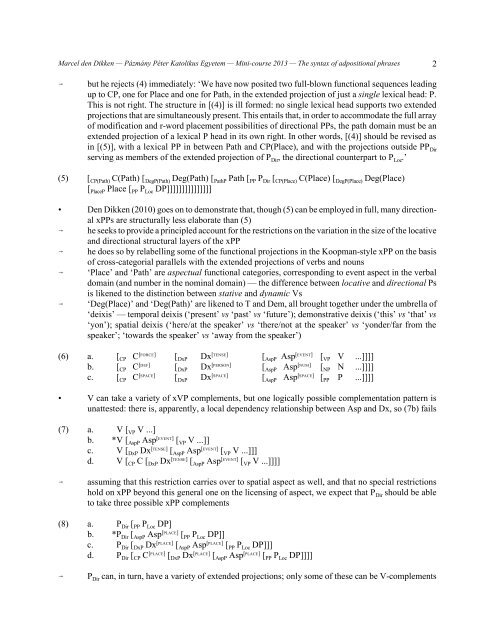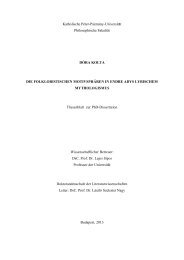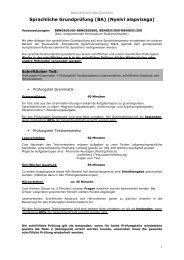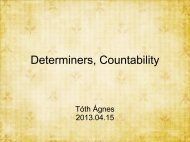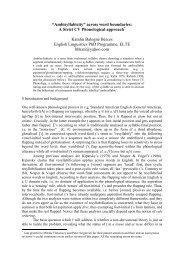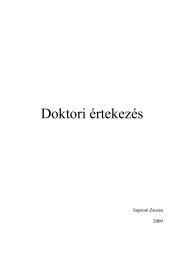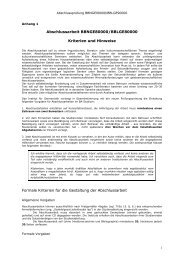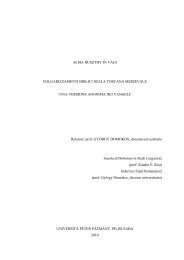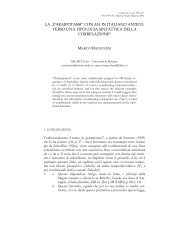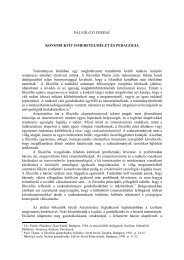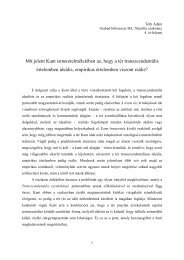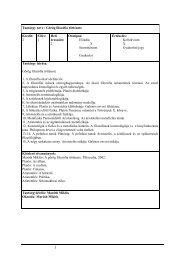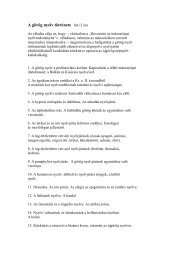Pázmány Péter Katolikus Egyetem • Mini-course • 11–12 January ...
Pázmány Péter Katolikus Egyetem • Mini-course • 11–12 January ...
Pázmány Péter Katolikus Egyetem • Mini-course • 11–12 January ...
Create successful ePaper yourself
Turn your PDF publications into a flip-book with our unique Google optimized e-Paper software.
Marcel den Dikken — <strong>Pázmány</strong> <strong>Péter</strong> <strong>Katolikus</strong> <strong>Egyetem</strong> — <strong>Mini</strong>-<strong>course</strong> 2013 — The syntax of adpositional phrases<br />
2<br />
<br />
but he rejects (4) immediately: ‘We have now posited two full-blown functional sequences leading<br />
up to CP, one for Place and one for Path, in the extended projection of just a single lexical head: P.<br />
This is not right. The structure in [(4)] is ill formed: no single lexical head supports two extended<br />
projections that are simultaneously present. This entails that, in order to accommodate the full array<br />
of modification and r-word placement possibilities of directional PPs, the path domain must be an<br />
extended projection of a lexical P head in its own right. In other words, [(4)] should be revised as<br />
in [(5)], with a lexical PP in between Path and CP(Place), and with the projections outside PP Dir<br />
serving as members of the extended projection of P , the directional counterpart to P .’<br />
Dir<br />
Loc<br />
(5) [ CP(Path) C(Path) [ DegP(Path) Deg(Path) [ PathP Path [ PP P Dir [ CP(Place) C(Place) [ DegP(Place) Deg(Place)<br />
[ Place [ P DP]]]]]]]]]]]]]]]<br />
PlaceP PP Loc<br />
<strong>•</strong> Den Dikken (2010) goes on to demonstrate that, though (5) can be employed in full, many directional<br />
xPPs are structurally less elaborate than (5)<br />
he seeks to provide a principled account for the restrictions on the variation in the size of the locative<br />
and directional structural layers of the xPP<br />
he does so by relabelling some of the functional projections in the Koopman-style xPP on the basis<br />
of cross-categorial parallels with the extended projections of verbs and nouns<br />
‘Place’ and ‘Path’ are aspectual functional categories, corresponding to event aspect in the verbal<br />
domain (and number in the nominal domain) — the difference between locative and directional Ps<br />
is likened to the distinction between stative and dynamic Vs<br />
‘Deg(Place)’ and ‘Deg(Path)’ are likened to T and Dem, all brought together under the umbrella of<br />
‘deixis’ — temporal deixis (‘present’ vs ‘past’ vs ‘future’); demonstrative deixis (‘this’ vs ‘that’ vs<br />
‘yon’); spatial deixis (‘here/at the speaker’ vs ‘there/not at the speaker’ vs ‘yonder/far from the<br />
speaker’; ‘towards the speaker’ vs ‘away from the speaker’)<br />
(6) a. [ C [ Dx [ Asp [ V ...]]]]<br />
b. [ C [ Dx [ Asp [ N ...]]]]<br />
c. [ C [ Dx [ Asp [ P ...]]]]<br />
CP<br />
[FORCE]<br />
DxP<br />
[TENSE]<br />
AspP<br />
[EVENT]<br />
VP<br />
CP<br />
[DEF]<br />
DxP<br />
[PERSON]<br />
AspP<br />
[NUM]<br />
NP<br />
CP<br />
[SPACE]<br />
DxP<br />
[SPACE]<br />
AspP<br />
[SPACE]<br />
PP<br />
<strong>•</strong> V can take a variety of xVP complements, but one logically possible complementation pattern is<br />
unattested: there is, apparently, a local dependency relationship between Asp and Dx, so (7b) fails<br />
(7) a. V [ VP V ...]<br />
b. *V [ AspP Asp<br />
[EVENT]<br />
[ VP V ...]]<br />
c. V [ DxP Dx<br />
[TENSE]<br />
[ AspP Asp<br />
[EVENT]<br />
[ VP V ...]]]<br />
d. V [ C [ Dx<br />
[TENSE]<br />
[ Asp<br />
[EVENT]<br />
[ V ...]]]]<br />
CP DxP AspP VP<br />
<br />
assuming that this restriction carries over to spatial aspect as well, and that no special restrictions<br />
hold on xPP beyond this general one on the licensing of aspect, we expect that P Dir should be able<br />
to take three possible xPP complements<br />
(8) a. P Dir [ PP P Loc DP]<br />
b. *P Dir [ AspP Asp<br />
[PLACE]<br />
[ PP P Loc DP]]<br />
c.<br />
[PLACE]<br />
[PLACE]<br />
P Dir [ DxP Dx [ AspP Asp [ PP P Loc DP]]]<br />
d. P [<br />
[PLACE]<br />
C [<br />
[PLACE]<br />
Dx [<br />
[PLACE]<br />
Asp [ P DP]]]]<br />
Dir CP DxP AspP PP Loc<br />
P Dir can, in turn, have a variety of extended projections; only some of these can be V-complements


